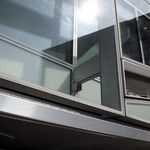| GLASS: Highly complex structures, verified by simulation methods |
| English Section Publicat de AG&F 29 Apr 2013 13:22 |
 Glazed elements included in the structure of the buildings’ envelope systems are the most vulnerable areas in terms of heat transfer. For example, the exterior masonry thermal transmittance lies at levels close to zero, but the insulating glass units (IGU) heat coefficients stand up to 0.7 W/sqm2K. Over time, scientists have made substantial efforts to improve the value or to minimize the heat losses. Some projects have been successful, so we can say now that the IGU panels came to performance. Nonetheless, it is possible for some innovations to change the field in the next period. Already, some companies have proposed specific solutions to limit heat transfer by convection (which is responsible, currently, for the most significant energy loss). A common requirement coming from beneficiaries and architects is to maximize the glass surfaces in order to increase the intake of natural light. For this reason, the transparent systems currently available on the international market must comply to additional downward U-values , in order to reduce energy consumption for heating in winter, or to maintain an optimal level of thermal comfort in summer. Unfortunately, even a non-specialist observer can identify some requirements that are completely contradictory. Therefore, it is useful to identify the weak points of glass. The first aspect is related to the safety barrier function. Typically, in such situations, the companies recommend triple glass IGU, including laminated and strengthened sheets. Feature durability represents another point of interest. Current standards define IGU panels as "hermetically sealed systems", which means that the gas pressure inside cannot be changed. If a balance between the environmental characteristics and the values of this pressure is maintained, the sheets remain flat and parallel to each other. The situation changes when, for example, the glazing is installed in a location where the atmospheric pressure is different from that existent in the manufacturing place. Unfortunately, as IGU thickness is larger, the effect is more pronounced, and the danger of failure increases exponentially. For further information and a detailed analysis of the current TOP-Fereastra issue click here! Glazed elements included in the structure of the buildings’ envelope systems are the most vulnerable areas in terms of heat transfer. For example, the exterior masonry thermal transmittance lies at levels close to zero, but the insulating glass units (IGU) heat coefficients stand up to 0.7 W/sqm2K. Over time, scientists have made substantial efforts to improve the value or to minimize the heat losses. Some projects have been successful, so we can say now that the IGU panels came to performance. Nonetheless, it is possible for some innovations to change the field in the next period. Already, some companies have proposed specific solutions to limit heat transfer by convection (which is responsible, currently, for the most significant energy loss). A common requirement coming from beneficiaries and architects is to maximize the glass surfaces in order to increase the intake of natural light. For this reason, the transparent systems currently available on the international market must comply to additional downward U-values , in order to reduce energy consumption for heating in winter, or to maintain an optimal level of thermal comfort in summer. Unfortunately, even a non-specialist observer can identify some requirements that are completely contradictory. Therefore, it is useful to identify the weak points of glass. The first aspect is related to the safety barrier function. Typically, in such situations, the companies recommend triple glass IGU, including laminated and strengthened sheets. Feature durability represents another point of interest. Current standards define IGU panels as "hermetically sealed systems", which means that the gas pressure inside cannot be changed. If a balance between the environmental characteristics and the values of this pressure is maintained, the sheets remain flat and parallel to each other. The situation changes when, for example, the glazing is installed in a location where the atmospheric pressure is different from that existent in the manufacturing place. Unfortunately, as IGU thickness is larger, the effect is more pronounced, and the danger of failure increases exponentially. For further information and a detailed analysis of the current TOP-Fereastra issue click here! |
ABONARE REVISTA (click aici): PROIECTE | INVESTITII | REVISTE | INDEX COMPANII
DATE DE CONTACT: Agenda Constructiilor & Fereastra - Tel/Fax: 021-336.04.16, 031-401.63.88
Documente
01 sep 2020
13 sep 2019
02 aug 2018




















































